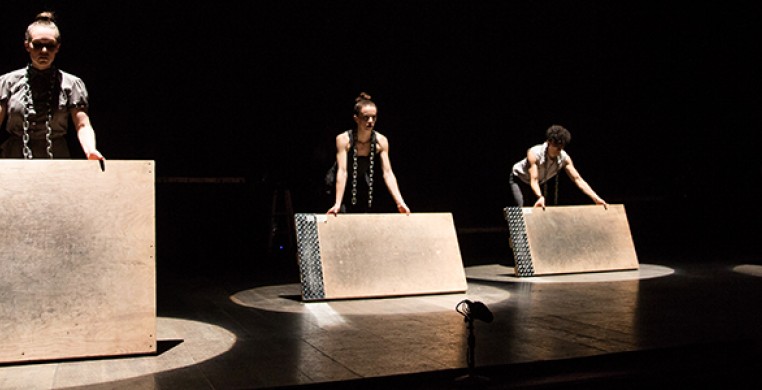We could have been witnessing the birth of angels at the touch of their lips in Susan Marshall’s “Kiss” (1987), opening “An Evening of Dance With MacArthur Fellows” at the Harris Theater this past Friday. Hubbard Street’s Jason Hortin and Jessica Tong, exquisite in Marshall’s poetry of weightlessness, were celestial bodies whose orbits intersected at that inevitable moment. The igniting kiss was both passionate and climactic, and yet the air-born dance built momentum on that theme to the very last moment. Suspended from harnesses and rigging, feet touching earth only long enough to push off into arcs of ecstasy, before careening off into space, the dancers magically played out the metaphor of falling in countless configurations of swinging, rising, reaching, clinging, and spiraling in and out of each other’s grasp, only to succumb each time to the inevitable pull of gravity into each other and the kiss at the center of their union. An entire drama of relationship unfolded in a dance of weightlessness and gravity, confinement and escape, perfectly set to Arvo Pärt’s hauntingly beautiful “Cantus in Memory of Benjamin Britten.”
Oh, Happy Day! Chicago is once again the beneficiary of private philanthropy that has delivered the gift of world-class dance to our doorstep, free and open to the public. Last month, we were treated to a full week of The Chicago Dancing Festival.
Friday, we were, each one of us, beneficiaries of MacArthur Genius grants, at least those of us who were lucky enough to snag a ticket to this delicious evening, free to the public, thanks to sponsorship by the MacArthur Foundation.
Celebrating 35 years of grant making across the arts, sciences, and social agencies, the John T. and Catherine D. MacArthur Foundation, based in Chicago, sponsored an unprecedented retrospective of five MacArthur Choreography Fellows, curated by Harris Theater’s outgoing managing director, Michael Tiknis. From the earliest—Merce Cunningham, (MacArthur Fellow, class of 1985)—to the most recent—Michelle Dorrance, (MacArthur Fellow, class of 2015), the program was testimony to the impact private philanthropy can have on artists’ ability to flourish at pivotal junctures in their careers, and on the lasting contribution of their work to the cultural fabric of civilization.
Each Dance Fellow’s work was charmingly introduced by MacArthur Playwrighting Fellow and DePaul Theatre School alum Tarell McCraney. While the narration was not essential to our enjoyment of the program, McCraney’s personal, anecdotal context highlighted what a crucial difference the MacArthur Foundation has made for individual artists, himself included.
It was especially refreshing to experience the diversity of style and creative range of five different choreographers’ work, four of them performed by their own companies. “Pacific” (1995) by Mark Morris (MacArthur Fellow class of 1991), was set to Lou Harrison’s “Trio for Violin, Cello, and Piano,” performed live. Four men and five women juxtapose highly stated, ceremonial gesture with flow and breath in sequences of group work, duets, and solos. Balletic pirouettes, pas de siseaux, and sautés combined with body collapses. Rigidly posed arms melted into fluid wings. Hands poised almost prayer-like in front of the heart suggest ritual, with pointed repetitive jumps in second position, but then group movement expands into joyous freedom, the movement capturing musical accents with delightful subtlety.  Mark Morris Dance Group in "Pacific"
Mark Morris Dance Group in "Pacific"
Merce Cunningham’s “Springweather and People” (1955), is set to Earle Brown’s piano solo “Indices,” performed live by Winston Choi. Dancers Erin Dowd and Forrest Hersey of the Cunningham Trust gave us a rare glimpse into some of the early underpinnings of Cunnigham’s innovations. Movement mirrored the seeming randomness of gesture in Brown’s a-tonal music, and yet there is an organic logic to Cunningham’s design. A surprising abundance of ballet vocabulary infused the more abstract, flat footed gestures, stark geometric lines of straight arms and legs, and an almost mechanical, robotic execution, the antithesis of the classical pas de deux. The etched shape, clean, stark lines, and deliberateness of each moment emphasized Cunningham’s acute focus on the movement itself as the only “meaning” of the dance.
Kyle Abraham (MacArthur Fellow class of 2013) offered an excerpt from “Dearest Home” (to be premiered in 2017), performed in silence by Abraham.In.Motion dancers, Tamisha Guy and Jeremy “Jae” Neal. The duet is the most literal representation of a male/female relationship of the three duets on the program, danced in the movement dialect of streetwise body language and attitude. The appealing couple, dressed casually in t-shirts and sweatpants, engaged in a movement conversation fraught with confrontation, ultimatums, reconciliation, appeasement, and affection.
Michelle Dorrance and Nicholas Van Young’s “Boards & Chains,” an excerpt from “ETM: Double Down,” creates a marvel of rhythm, texture and movement on four amplified wood squares, each occupied by one tap dancer and a heavy metal chain. The dancers build a universe of sound and rhythm, scraping heals to create a grating rasp underneath the crips slaps, shuffles, and paradiddles of their human gamelan. Dorrance takes the art of tap to new heights as a legitimate concert dance genre. Her use of the entire body, with ample attention to the amplification of sound and rhythm through arm and torso movement and not just the feet, is as engaging visually as it is aurally.

